Abstract
Background This paper aims to highlight the importance of functional complex "ankle-leg" which aims to support the weight of the body and enable it to move on any terrain. Because the fetus that across the ankle joint can produce a series of macro - trauma such as contusions, sprains, dislocations, they may affect all anatomical structures and can leave scars immediate or delayed whose link with the trauma that it is not difficult to determine. Objectives The study aims to improve trauma to the ankle by applying modern methods and kinetic means. Material and methods The research was conducted within Volleyball Club "Castelo da Maia" Porto, Portugal and was to implement a program to recover kinetic strain on the ankle in a case study of a volleyball player. Results: Treatment results show values highlighted by evaluating kinetic parameters of the athlete showings improvement target: testing joint flexion -extension and inversion - eversion articular testing. Conclusions: Given the differences between tests suggest developing a program to recover kinetic strain on the ankle, in order to shape a methodological framework for its implementation within the game of volleyball.
Keywords: Lesionthe ankle jointkinetic program recoveryvolleyball game
Introduction
The game of volleyball is a sports complex characterized by an effort acyclic, predominantly
anaerobic phases of the game is repeated many times the lock (Fig.1), blow attack, during which the
locomotor apparatus is required at all times both the upper body and the lower (Drăgan, 2009).
Volleyball game has evolved a lot in recent years it is characterized by speed and variety of game
action and creativity in building attack combinations and flexibility in the choice of defense. High
performance across teams witnessing increasing the pace of play and the number of simulations to attack
and change in the distribution of shares of attack over the net in order to increase the degree of
uncertainty and hindering the efficient organization of thelock opposition. It was also observed increased
labor service, which is becoming more and more a weapon of attack of the team (Rusu, & Șanta, 2009).
Țurcanu & Neamţu (2009) states that during volleyball training methodological guidance is needed to
model their content, requiring an element of surprise in the phase.
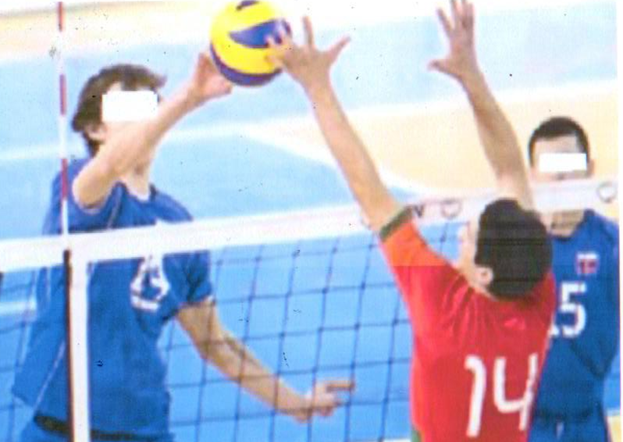
The game of volleyball doesn't cause serious injury, but the device engine and upper limbs have
suffered trauma repeated overload leading to injuries of muscles, disinsertion extensors in the toes,
contusions, bursitis elbow, knee, shoulder and sprains ankle volleyball player (Marcu, & Dan, 2010).
Factors influencing appearance in the game of volleyball sprains are multiple: they are divided into
intrinsic and extrinsic factors. Extrinsic factors are factors not related to the athlete. They are represented
by training errors giving rise to overloading and hence the emergence ankle sprains, lack of exercise
program of balance and proprioceptive exercises increase the risk of ankle sprains level.
Practicing volleyball game has known lately evolved extraordinary and the overall result of this
phenomenon sport is followed in the medical plan for an increase of pathology traumatic acute, since this
is a contact sport, where movements are executed from routine (Avramescu, Ilinca, Zăvăleanu, & Enescu
- Bieru, 2006, Introduction, para.1).
Another factor favoring the occurrence of injuries to the ankle is the quality sports equipment and
inadequate training or playing field these factors can have a negative influence on the ankle.
Intrinsic factors are related to anatomical and biomechanical characteristics of the athlete, that
favor the emergence sprains through sport-specific neuromuscular skills, insufficient or a return to the
sport without injury is completely healed leading to increased risk of injury (Drăgan, 2002).
Bădicu & Balint (2014) states that health can be improved, among other things, on the one hand
the awareness of the need to practice continuous sports activities and on the other hand, the range of
opportunities to show motive, that player volleyball can practice.
Purpose of the Study
Relevance of the theme to be debated in this paper is due to the high frequency of trauma ankle
volleyball game worldwide and particularly in our country. Despite the fact that in recent years the sport
has evolved a lot and with it and methods of prevention it is worth noting that the first place in injuries
from playing volleyball are sprains ankle, which affected at least once in life player volley-ball.
Research Methods
The study was conducted in 2012 at the Castelo da Maia Volleyball Club in Porto, Portugal. The
subject of the case study (J.B.) aged 18, member of the volleyball club and has a second degree sprain of
the left leg.
Mode for the production of the strain is reversed, the left foot ankle joint appears greatly enlarged
top plan (Fig.2.) and on the front of the left ankle part has a swelling accompanied by edema (Fig.3.).
The research included two moments of assessment, initial testing amplitude joint intervention was
performed after producing trauma and final testing, which took place after 71 days, which was conducted
program kinesiology - functional proprioceptive designed to relieve trauma.
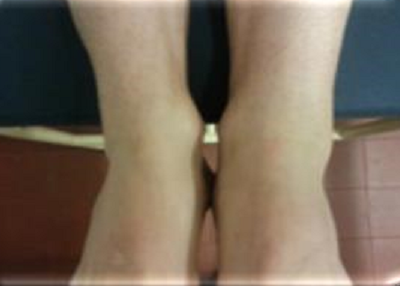
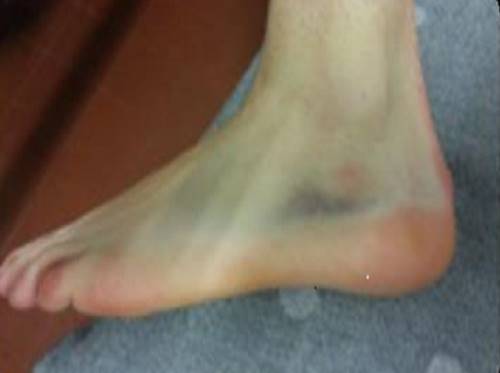
Implementation of physical therapy, proprioceptive function was performed by the following
steps using different means:
Phase I of the program kinetic - Acute seven days - includes the following objectives: reducing
pain, control inflammation and ankle protection.
At this stage, the modalities of intervention included the following:
Pharmaceutical treatment – NSAID administration role in reducing inflammation and pain;
Electrotherapy – inflammatory and analgesic (ultrasound and electric stimulation) (Fig.4.);
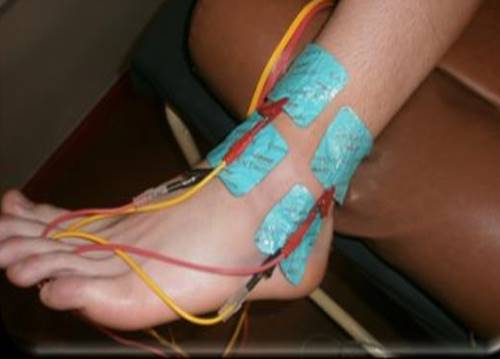
-
Kinesio tapping
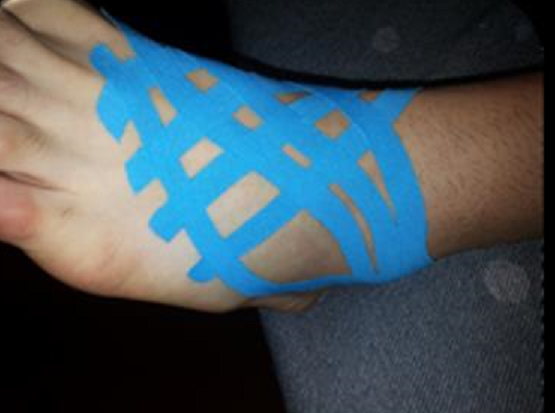
Phase II chronic, lasting 71 days following objectives: restoring muscle strength and
proprioception recovery.
Methods of intervention:
-Exercises for restoring joint mobility: active mobilizations - from sitting in the chair with a ball
elastic support ping running tip - heel foot on the ball (Fig.6. and 7.). Runs 2 sets of 8 repetitions
with 30 seconds break.
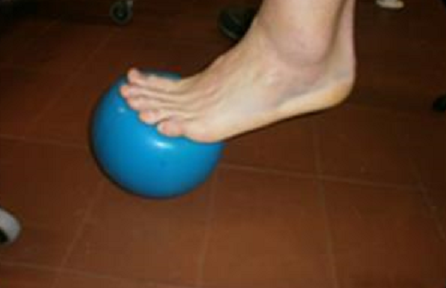
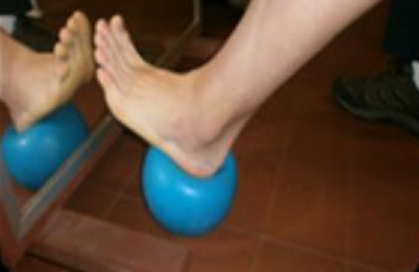
-Exercises for balance and proprioception: the sitting position on his left foot, the patient performs
assists with two hands above the wall, 2 sets of 30 repetitions with 40 seconds break (Fig.8.).
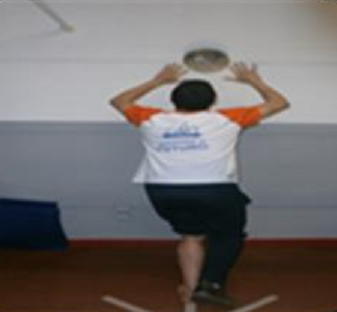
-Specific exercises volleyball game: away from the standing position, lateral displacement stop the
takeover fundamental position 3 sets or 100 meters, break 3 minutes (Fig. 9.).
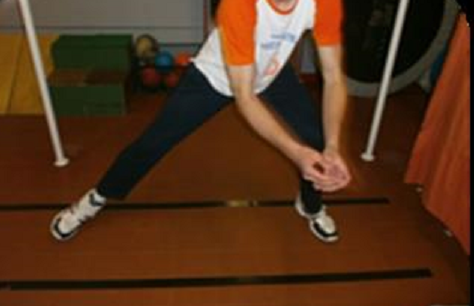
Findings
Table
Table
compared in terms of differences such testing are centralized.
According to the comparative analysis between the initial and final case study shows the following
value differences:
-We note that the J.B. it shows an improvement in the flexion of the ankle joint 4° and the
extension movement of a value of 8°.
-These differences are significant because the subject has progressed in flexion value - extension
left ankle.
- In terms of comparative values from eversion - inversion, inversion of the constant movement
recorded significant value of 5° and eversion was maintained at the same value.
Thus, these increases compartments from one test to another induce us that in a relatively short period,
it has worked effectively, aiming at selecting the most effective kinetic musical media and thus obtaining
sports injuries improvement.
It demonstrates that the data reveals that the range of motion of the affected member shows
identical with the unaffected member. Thus, in tables
were significant increases from initial testing to final testing subject J.B.
Following the experience of involvement in this research on identifying and implementing means
kinetic appropriate case study during a work period relatively short, data analysis in research of existing
scientific data in the literature, can say that it is necessary to implement these measures to avoid injury in
the latter stages of the game and if their production to address this situation on a higher level by finding
the most efficient means and methods kinematics.
Conclusions
Based on the study of literature and interpretation of results, the following conclusions:
The results depend on functional rehabilitation program: development of the disease, early
diagnosis of disease stage, the cooperation of patients, methods and means used and the training of
specialists.
Comparing the initial results of the final I found that yielded positive results in terms of the
parameters tested: joint mobility.
By using the latest techniques for treating sprains and develop an individualized program of
physical therapy have reduced recovery period the athlete facilitating its return to athletic activity.
Paying particular attention to balance and proprioception exercises have improved static problems
of the patient and improved ankle stability. Thus, the patient is no longer prone to relapse.
In the treatment program specific exercises were used as physical therapy and specific exercises
volleyball realizing an attractive treatment program for the patient. Thus, during treatment program was
considered patient response to applied techniques for getting a positive feedback from him.
References
- Avramescu, E.T., Ilinca, I., Zăvăleanu, M., & Enescu - Bieru, D. (2006). Abordarea metodologică a factorilor de risc în traumatologia sportivă din volei. Journal of Romanian Sports Medicine, 2(6).
- Retrieved from http://www.medicinasportiva.ro/SRoMS/revista/Nr.6 2006/Abordarea metodologica a factorilor de risc in traumatologia sportiva din volei.html.
- Bădicu, G., & Balint, L. (2014). The influence of practicing leisure sports activities on physical, mental and social Health, as elements integrated in the quality of life. Gymnasium Scientific Journal of Education, Sports and Health, 15(2),57-66.
- Drăgan, I. (2002). Medicina Sportivă. București:Editura Medicală, ISBN 973-39-0494-5,285-286, 781.
- Marcu, V., & Dan, M. (2010). Manual de Kinetoterapie. Editura Universității din Oradea, ISBN 978-606-10-0284-9, 149.
- Rusu, F., & Șanta, C. (2009). Curs Volei. Retrieved from https://www.scribd.com/document/91926054/Curs-Volei-2009.
- Țurcanu, D.S., & Neamțu, M. (2013). The II- line attack – crucial technical element in the game of volleyball. Bulletin of the Transilvania University of Braşov, 6(55), 59-64.
Copyright information

This work is licensed under a Creative Commons Attribution-NonCommercial-NoDerivatives 4.0 International License.
About this article
Publication Date
25 May 2017
Article Doi
eBook ISBN
978-1-80296-022-8
Publisher
Future Academy
Volume
23
Print ISBN (optional)
-
Edition Number
1st Edition
Pages
1-2032
Subjects
Educational strategies, educational policy, organization of education, management of education, teacher, teacher training
Cite this article as:
Nechita, F., Cioroiu, S. G., & Vescan, A. (2017). Role Of Physical Therapy In Recovery Kinetic Ankle Sprains Level Volleyball Player. In E. Soare, & C. Langa (Eds.), Education Facing Contemporary World Issues, vol 23. European Proceedings of Social and Behavioural Sciences (pp. 1484-1492). Future Academy. https://doi.org/10.15405/epsbs.2017.05.02.182

